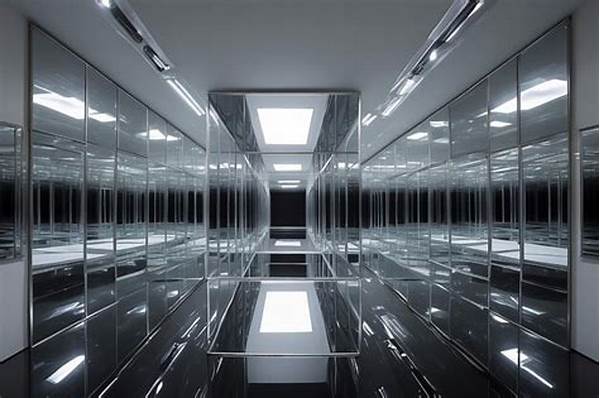In the realm of interior design, the challenge of maximizing space is a universal struggle. Whether you’re living in a quaint urban apartment or expanding your cozy country cottage, the illusion of more space is a coveted aspiration. Enter mirrors, a designer’s secret weapon, much like a magician’s trick. Mirrors are more than mere reflective surfaces; they are transformative tools that add depth and dimension to any room. How to use mirrors to create space illusions? It’s more than just hanging a mirror on a wall; it’s about strategically placing it to leverage its full potential.
Read More : Top Space Saving Furniture Designs In 2025
Let’s face it, we all want our homes to look spacious and inviting, a retreat from the bustling world outside. The art of illusion through mirrors offers an elegant solution. Mirrors invite light into spaces, make dark corners vanish, and visually expand cramped interiors. It’s like waving a magic wand, but without the need for a top hat or a rabbit. We’re here to dive into the strategy behind utilizing mirrors to their fullest, creating spaces that not only feel larger but are also aesthetically pleasing.
So, why exactly do mirrors create such a compelling illusion? It all comes down to their ability to reflect light. This phenomenon isn’t just scientific but also a beautiful interplay of light and perception. Even the smallest mirror can amplify the natural glow from windows or accentuate artificial lighting from lamps. It bounces it around the room, dispelling shadows, and creating an airy feeling. Moreover, mirrors introduce depth by reflecting parts of the room so precisely that they essentially double the visual space.
Imagine hosting a dinner party in a dining room outfitted with strategically placed mirrors. Not only will your space appear grander, but the mirrors also reflect the energy and vibrancy of the setting, elevating the overall ambiance. So, our mission? To empower you with techniques on how to use mirrors to create space illusions, transforming your living quarters into a must-see spectacle that’s sure to impress.
The Science of Reflection and Space Expansion
Mirrors have long been associated with luxury and elegance, but their practical applications in interior design cannot be underestimated. The strategic placement of mirrors can lead to visually pleasing results, making how to use mirrors to create space illusions not just a skill but an art form. Imagine entering a compact room and feeling enveloped in a sense of openness and tranquility, all thanks to the clever utilization of reflective surfaces.
Consider the colors in your space. Lighter shades paired with large mirrors can immensely enhance the breadth of any room. Adding mirrors to darker spaces can equally aid in lifting and brightening the environment, crafting an even more significant expansion effect. This interplay of light and reflection can transform the mundane into the extraordinary, reinventing living spaces with minimal effort.
Did you ever notice how mirrored walls in restaurants or retail shops make them appear larger and smarter? This isn’t a coincidence. Retailers and restaurateurs utilize these principles to enhance their customers’ experiences, drawing them deeper into their ambience. It’s fascinating how a simple pane of glass with a reflective backing can achieve such powerful outcomes.
Adding mirrors is also an excellent way to direct focus within a room. They can be used to highlight statement pieces, create a focal point, or even artfully disguise unwanted features. The versatility of how to use mirrors to create space illusions extends far beyond just making rooms appear larger. It involves curating an environment that tells a story, enriches experiences, and maximizes architectural beauty.
—
Discussion: Exploring the Depth and Magic of Mirrors
Even though mirrors have been a household staple for centuries, there’s an almost mystical allure to their optical wizardry. If you’ve ever wandered through a funhouse full of mirrors, you know firsthand the sensation of walking into an expanse of infinite corridors and daunting reflections. This same captivating effect is what makes how to use mirrors to create space illusions such a thrilling endeavor in home décor.
One could argue that mirrors are the unsung heroes of interior design. They are inherently unassuming when purchased but incredibly impactful when deftly applied. Walking into a room seamlessly adorned with mirrors can immediately alter your perception of space. It’s as if each mirror whispers to you, convincing you of the expansiveness and grandeur that isn’t physically there but is nonetheless felt.
Many of us have encountered that existential moment when stepping into an elevator lined with mirrors, feeling as though we’re stepping into another dimension. This is exactly what you can recreate in your home, providing an engaging experience for yourself and your guests. Embellishing your interiors with mirrors doesn’t just trick the eye; it invites curiosity and sparks conversation.
How Strategic Placement Creates Illusions
The positioning of mirrors is crucial to their effect. Proper placement boosts efficacy in how to use mirrors to create space illusions. Much like an artist with a canvas, understanding where light sources are and how they can be reflected is paramount. Rooms that favor large windows or other light sources benefit hugely from opposing mirror placement, optimizing the reflection of light throughout the area.
Experimentation is key. Trial and error with different angles and heights can drastically change the perception of the room. Mirrors can be used to add height, reflect architectural features, or simply create a feature wall that plays with perspective in delightful ways. In a sense, mirrors perform a dance with light and surroundings, adjusting angles and reflections to produce charming spaces.
When applying mirrors to increase the perception of space, consider asymmetry and layered reflections for added depth. Incorporating a variety of mirror shapes and sizes not only enhances the perception of space but adds a layer of artistic flair. Decorative frames and unique mirror shapes augment the character of your room, making it truly unique.
—
Goals for Utilizing Mirrors Effectively
Introduction: Why Mirrors Matter
Mirrors, often viewed as mere household essentials, conceal a profound ability to transform spaces. Within the confines of interior design, they stand as both a functional necessity and an artistic tool. Why does how to use mirrors to create space illusions matter? The answer lies in their unrivaled prowess to alter perceptions of space and light, crafting an environment that is both welcoming and elegant.
Envision a home office, charming yet cramped. With just the right mirror positioned strategically, that compact workspace can evolve into an area that inspires creativity and boosts productivity by fostering a sense of openness. Similarly, in a petite powder room, a well-placed mirror can translate into a luxurious oasis, dispensing light and levity throughout the space.
In heartfelt storytelling of interior design transformations, mirrors often play the unsung hero. Harnessing the power of reflection brings with it a promise of innovative change and a more comfortable living environment. So whether you’re a seasoned designer or a homeowner with a flair for redecorating, embracing the subtle yet powerful art of how to use mirrors to create space illusions can pivot your spaces from ordinary to extraordinary.
The Efficacy of Mirrors: An Exploration
The advent of minimalism has cast a spotlight on making the most with less, and mirrors are at the forefront of this trend. Their capability to create space illusions cleverly aligns with minimalist aesthetics by introducing light and openness without excess clutter. With mirrors, less truly is more—a truth that manifests vividly in how these humble pieces of decor can redefine vast open spaces and tight corners alike.
Mirrors, whether grand antique full-length or sleek modern circular, integrate effortlessly within any style or theme. They are more than an accessory; they’re a bridge between form and function. As we proceed to delve deeper into the art of utilizing mirrors as tools for spatial enchantment and illusion creation, keep in mind that every reflective surface you blend into your environment contributes to a story—one that speaks of cleverness, creativity, and ultimately, comfort.


